Poland are a last-minute addition to the Euros after a play-off penalty shootout victory over Wales, following a 0-0 draw and a 5-1 beating of Estonia in the prior stage.
Following a rocky qualifying campaign, they received a second bite at the cherry, sacking the experienced Fernando Santos and opting for Michał Probierz, a manager who has experience on the international stage but only with the Polish youth sides.
Poland’s last Euros results were disappointing, and they struggled to reach the highs of Euro 2016.
This time round, Poland has been drawn into the group of death alongside France, the Netherlands, and an in-form Austria.
This tactical analysis will discuss whether or not Poland have a chance at progressing to the next stage or not, and if they do, the tactics that will allow them to do so.
The analysis will focus on Poland’s games since Probierz took charge in September and how he has been setting his team up in the past few months.
We will predict their starting line-up ahead of the EURO 2024 tournament and how they will set up when attacking and defending.
Since the managerial change, Poland have not faced a side of the quality of France, so it is unclear if they will change their style completely, but we can expect them to respect the firepower of the stars they will face and focus on protecting their goal.
Predicted Starting XI
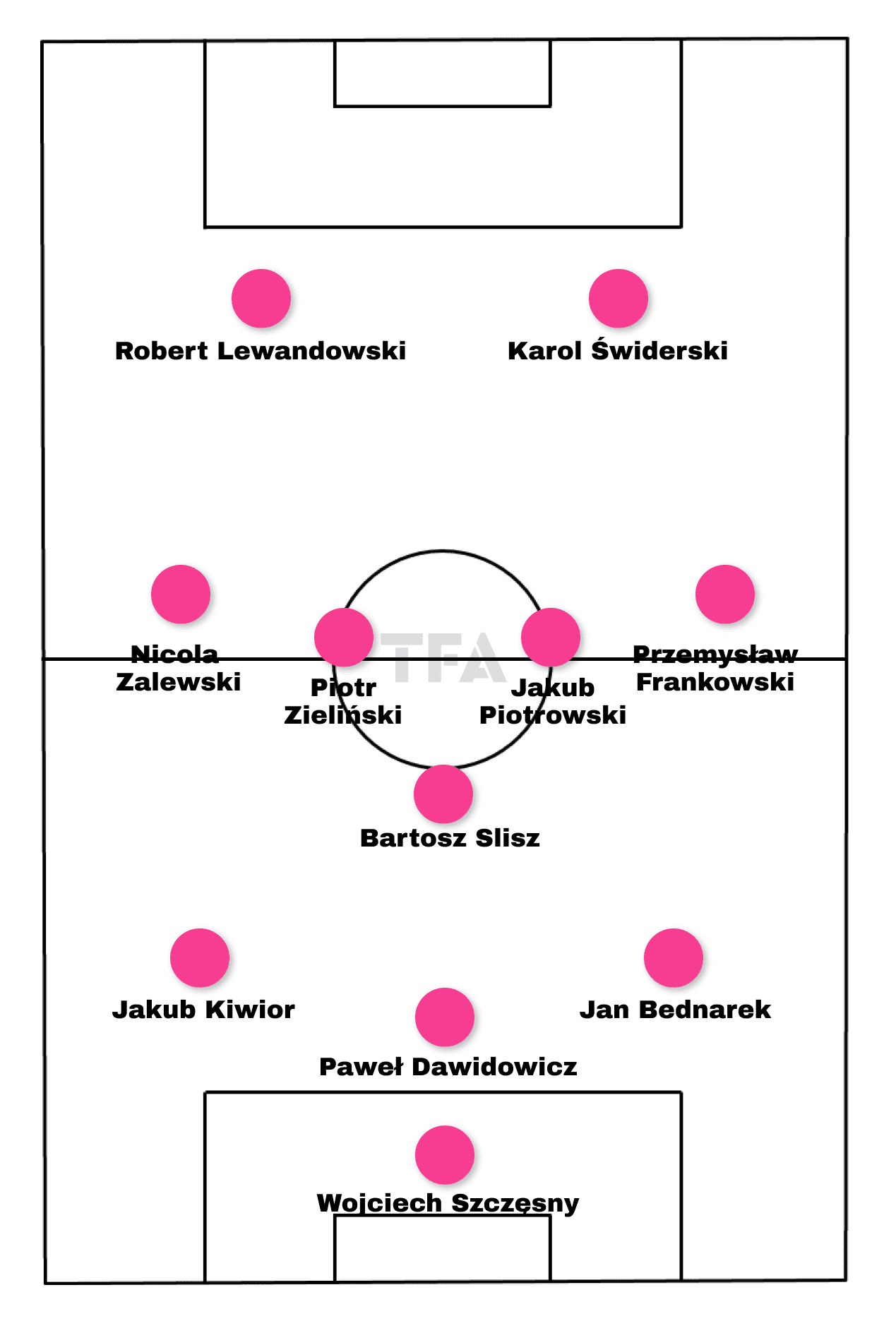
Robert Lewandowski will lead the line for Poland.
Although Barcelona’s underwhelming season wasn’t up to expectations, Lewandowski’s form picked up towards the back end of the season just in time for the Euros.
Świderski will partner him on the right-hand side, with the left-footed striker being the best of the remaining striking options, although his form of late has been weaker.
Nicola Zalewski is a winger who will be used at left wing-back due to his ability to pose a threat through dribbling and crossing from the left flank.
At the same time, he also has plenty of experience in the position whilst playing under José Mourinho for AS Roma.
On the opposite side, Frankowski is a similar profile of player who will be used after a strong couple of seasons with RC Lens in that position.
In the centre of midfield, Zieliński will be crucial to Poland ahead of his transfer to Serie A champions Inter Milan in the summer.
Alongside him, Jakub Piotrowski is a fairly new addition to the squad.
Still, his performances for Ludogorets have allowed him to stand out as a box-to-box towering midfielder with an eye for goal, scoring 11 goals in 29 league starts.
Bartosz Slisz will sit at the base, having started to cement that spot in Krychowiak’s absence since the new manager’s arrival.
Jakub Kiwior of Arsenal will play as the left-sided central defender, while Jan Bednarek will be on the right-hand side, with both players key to Poland’s defensive system in slightly more aggressive roles.
Paweł Dawidowicz is likely to start at the centre, although this position is uncertain, with numerous players taking it up in the last few games.
Wojciech Szczęsny will start in goal and look to keep up his strong form for Poland, building on his penalty shoot-out heroics in the Qatar World Cup in 2022 and in the recent play-off game against Wales to qualify for the Euros.
The squad is on the older side, with most players at the peaks of their career ready to perform and a few ageing players, while Zalewski is the only U23 player.
Pressure shouldn’t affect this team, and it hasn’t been in the high-pressure playoff games against Wales, Estonia, and Sweden in recent games.
Many young talents have been involved in one-off games and are ready to step up in future tournaments, but when the stakes are so high, Probierz opts to trust his experienced players.
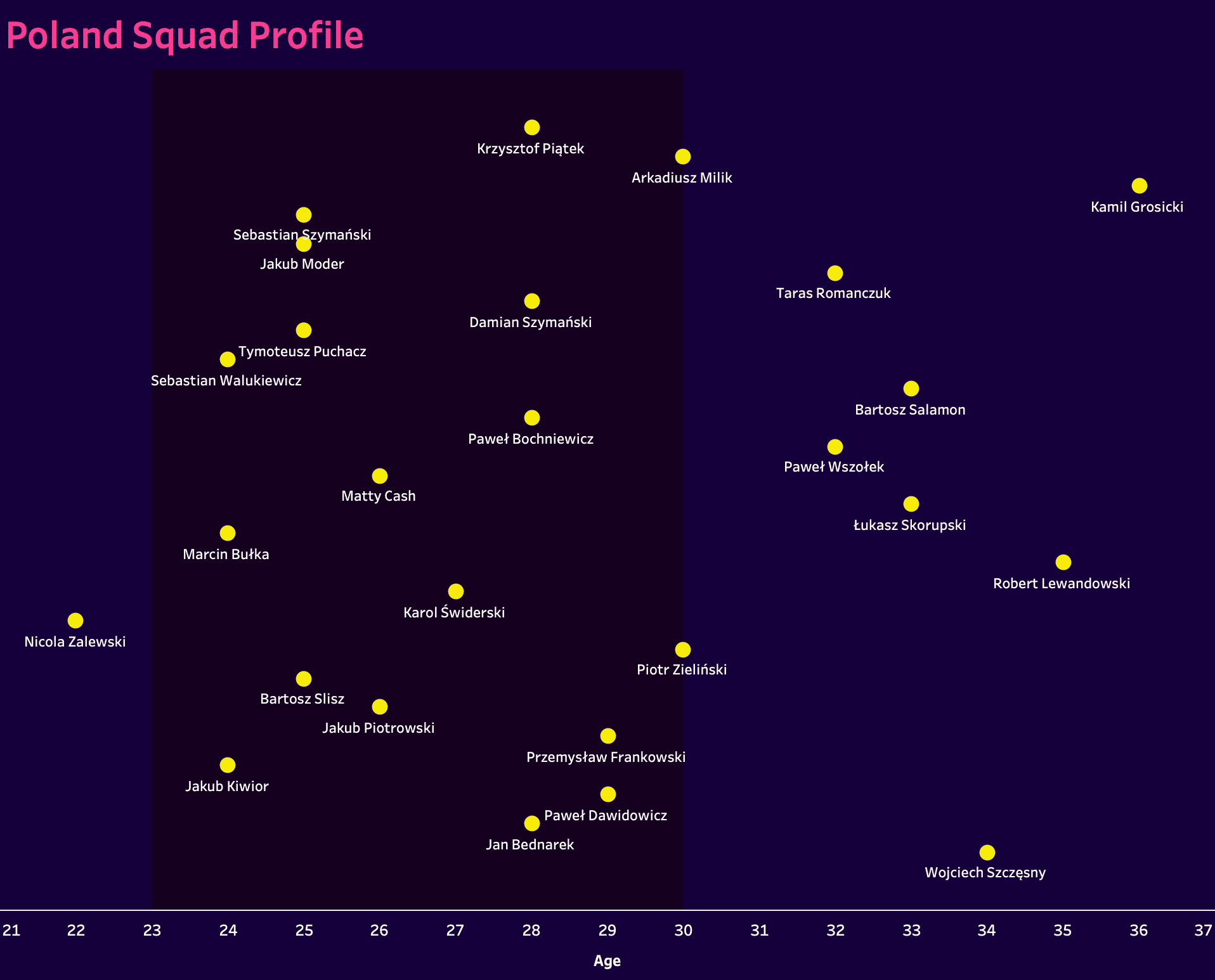
Attacking Phase
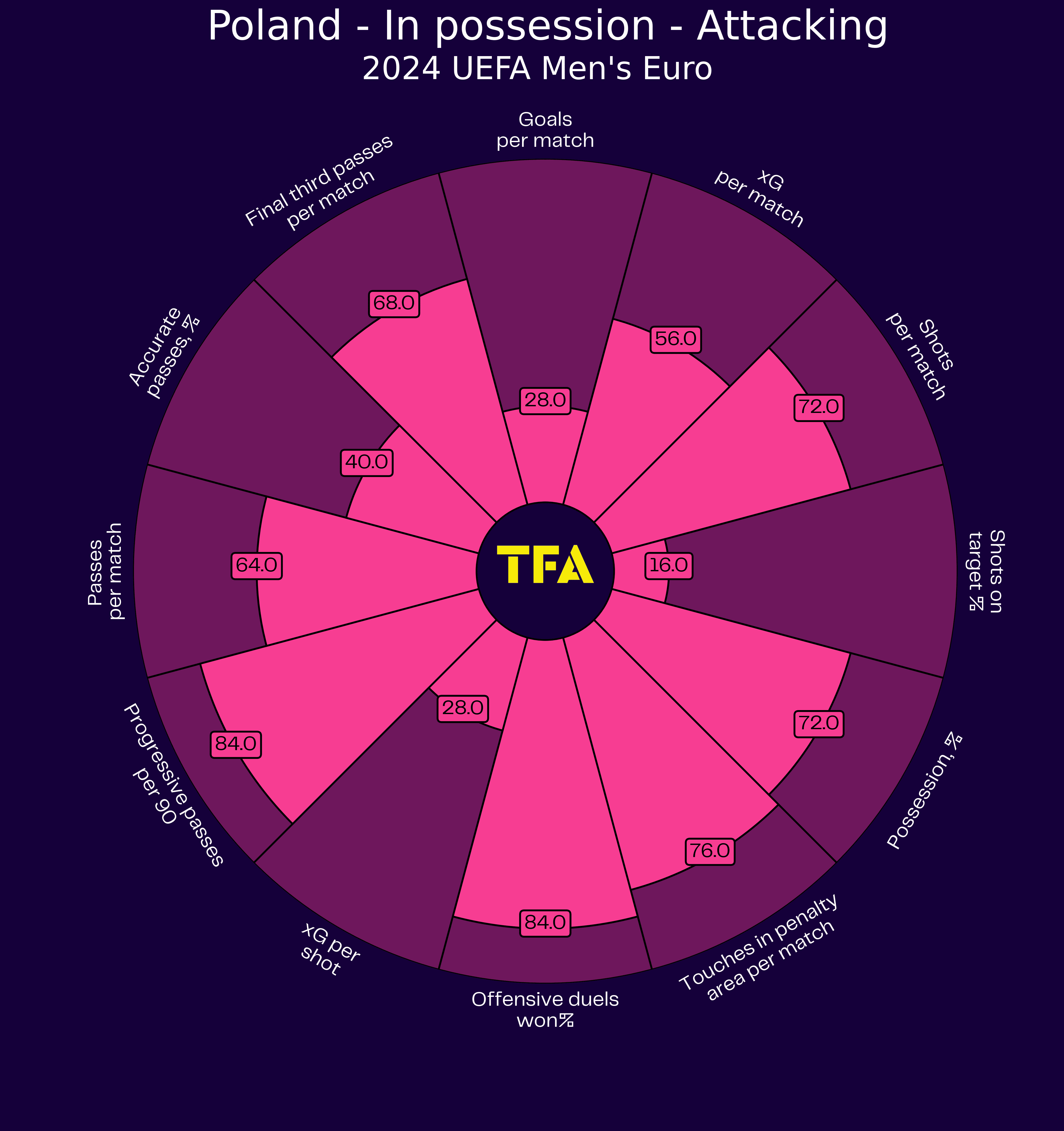
The graphic above instantly tells you what to expect from Poland in the upcoming Euros.
Ranking lowly in goals per match, xG per shot and shots on target %, we can tell Poland won’t be scoring too many goals this summer.
With the star power of Robert Lewandowski, finishing ability is not the problem; instead, the limited number of chances the attackers receive per match.
The above statistics are taken from the last calendar year, which involved Poland playing many ‘smaller’ nations in the qualifying campaign where they would be seen as favourites.
Even with the favourable fixtures, they have struggled to be high-scoring or creative in front of goal while dominating possession.
When facing their opponents in the group stage, the higher difficulty of opposition will likely see these statistics decrease even further as possession is reduced.
From goal kicks, Poland will avoid taking unnecessary risks.
The defensive unit drops deep to provide passing options; however, rather than playing through pressure, the aim will be to go long into the strike partnership.
As the defensive players are showing for the ball, opposition sides will be stretched as they attempt to pressure the ball, while the defensive line has to cover for the long ball, with no threat of offsides from goal kicks.
This will leave space between the defensive and midfield lines, which Lewandowski will look to drop into to receive the ball.
He has the ability to bring the ball down with any part of the body and will be able to control the ball and either turn or lay the ball off to a teammate, depending on how much time and space he has.
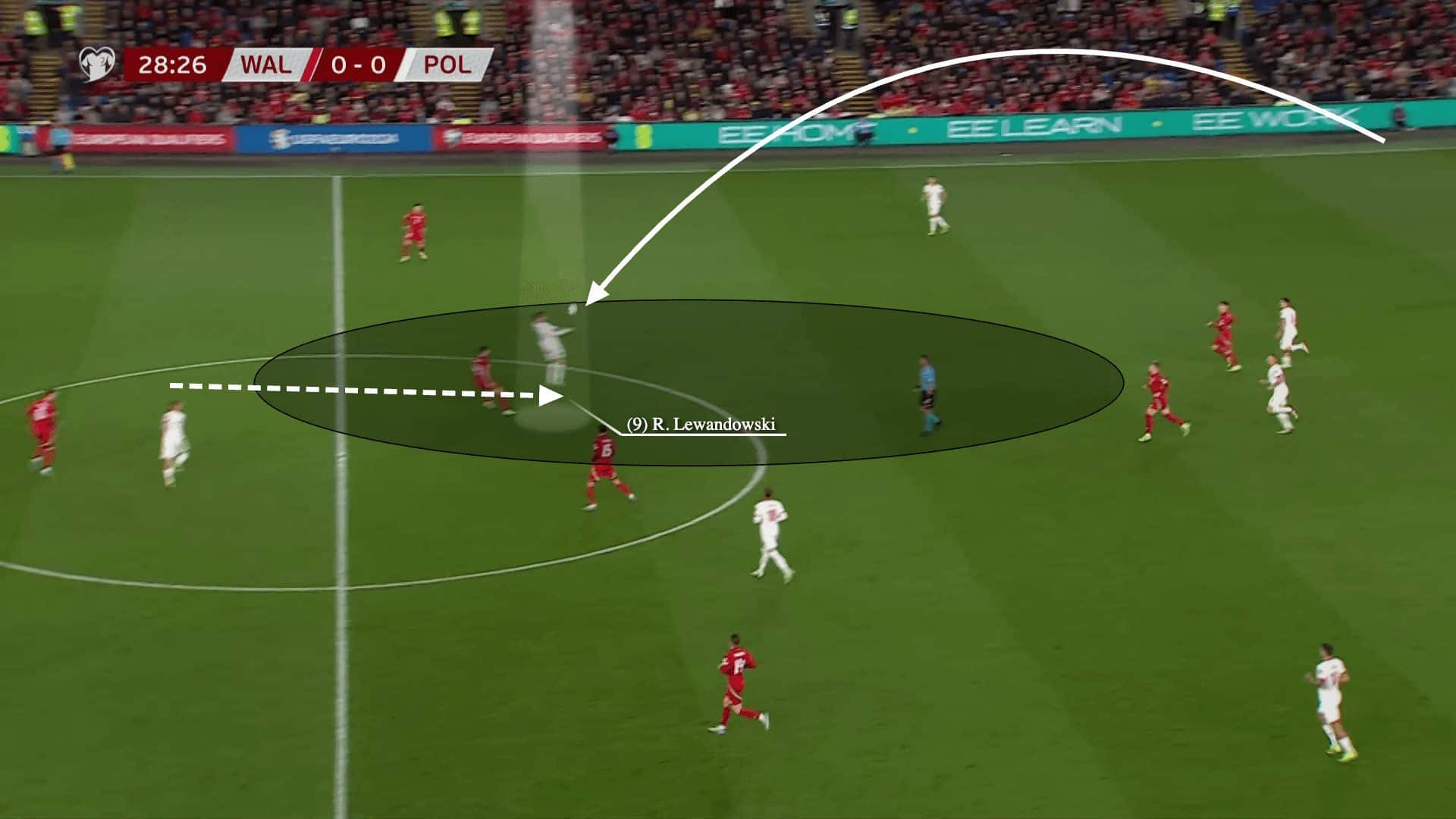
When the Eagles manage to have settled possession inside their half, their wing-backs push up high to act as wingers, forming a 3-3-4 shape.
The three central defenders and midfielders help to ensure they have a strong and secure base in possession.
Having six bodies in close proximity who shift horizontally across the width of the pitch mean that Poland are always in a good position to attempt short passes to retain possession, as well as having enough bodies to be able to win many second balls following turnovers.
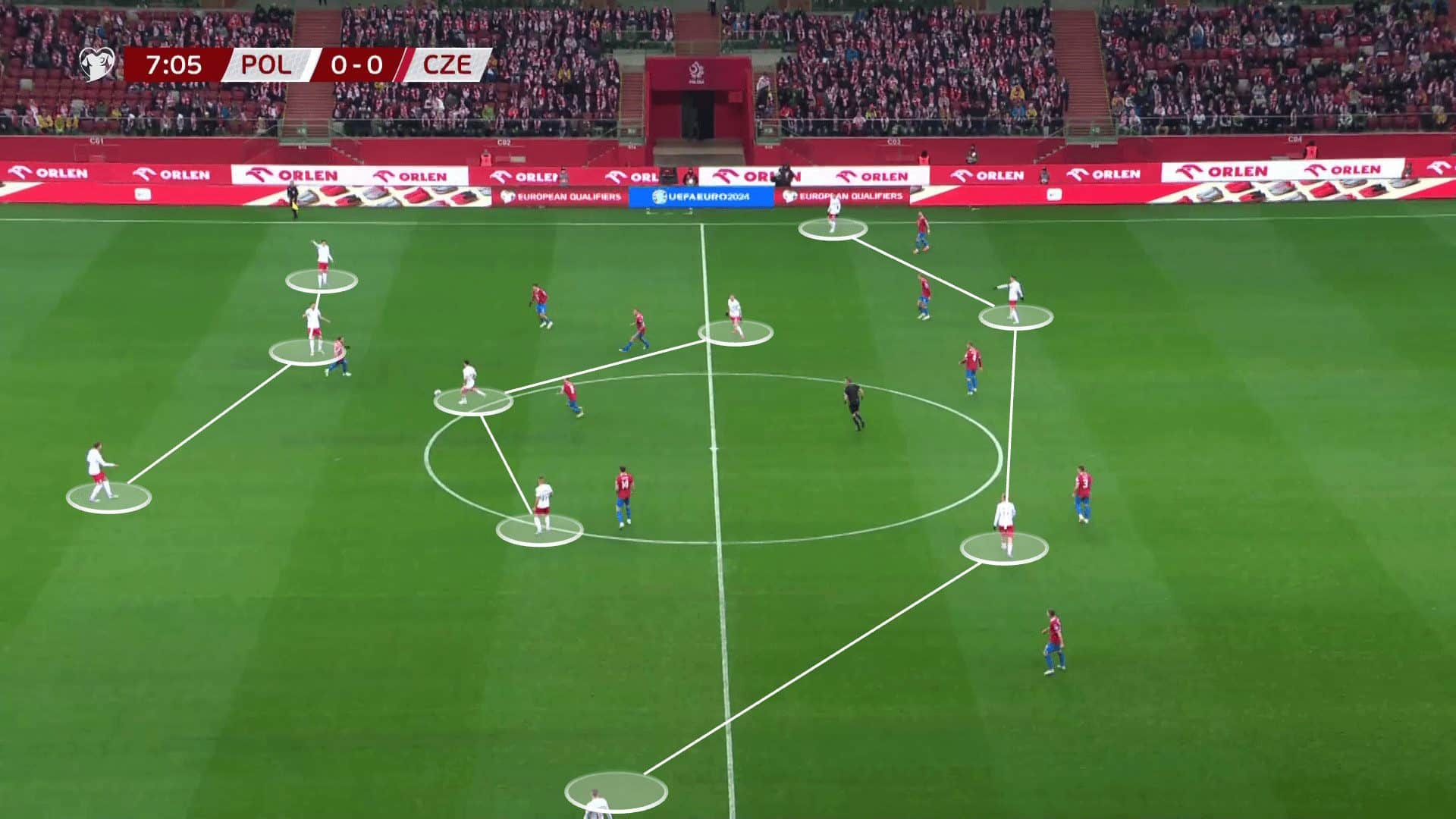
The three at the back base usually provides Poland with an overload at the first line, which gives either of the wide centre-backs the chance to regularly progress the ball by carrying it into the next third before releasing the wing-back into the final third with a long ball in behind.
Most of Poland’s play will involve attempting to attack the space in wide areas through passes into space for the wing-backs to receive, who will be crucial to any chances that Poland do create and score.
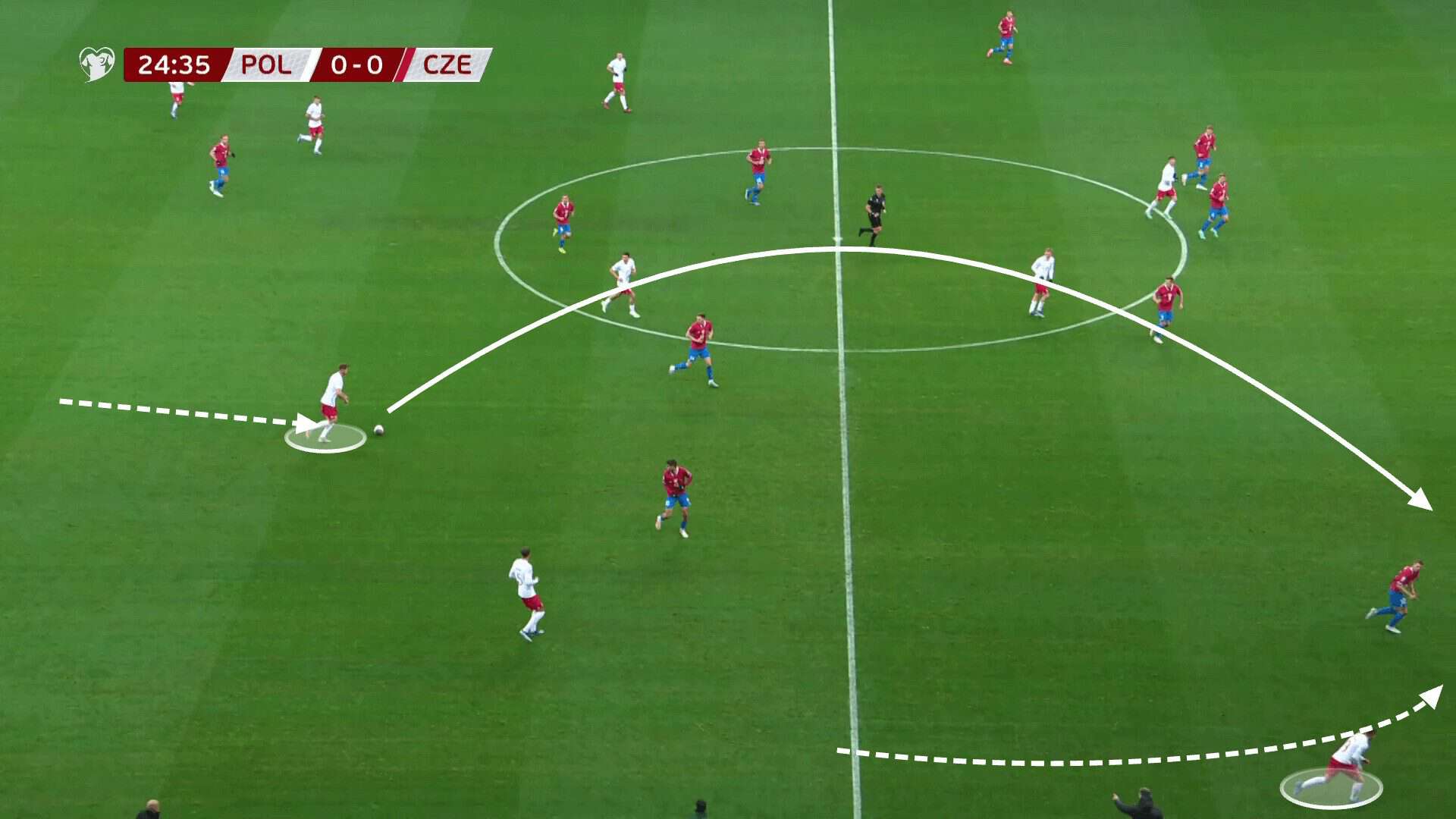
Another common pattern we can expect to see from Poland will be the use of underlapping runs when the wide player receives to feet instead.
When the pass into space isn’t on, the wing-backs will drop to receive the ball to feet, dragging the opposition full-back out of position when they come out to close down the ball.
In doing so, the wide spaces in the last line will open up, which will be attacked by the outside central midfielders through underlapping runs.
The idea behind this is positive.
However, the profile of players Poland have in central midfield doesn’t exactly bring the best out of them in wider areas.
After receiving the pass in the wide area, players who are quick and comfortable in wide spaces and those capable of crossing the ball into space between the goalkeeper and defensive line would make the most of these situations.
However, Piotrowski, who will likely play as the right-sided central midfielder, is more suited to crashing the box and roaming in central areas to take part in duels and collecting second balls.
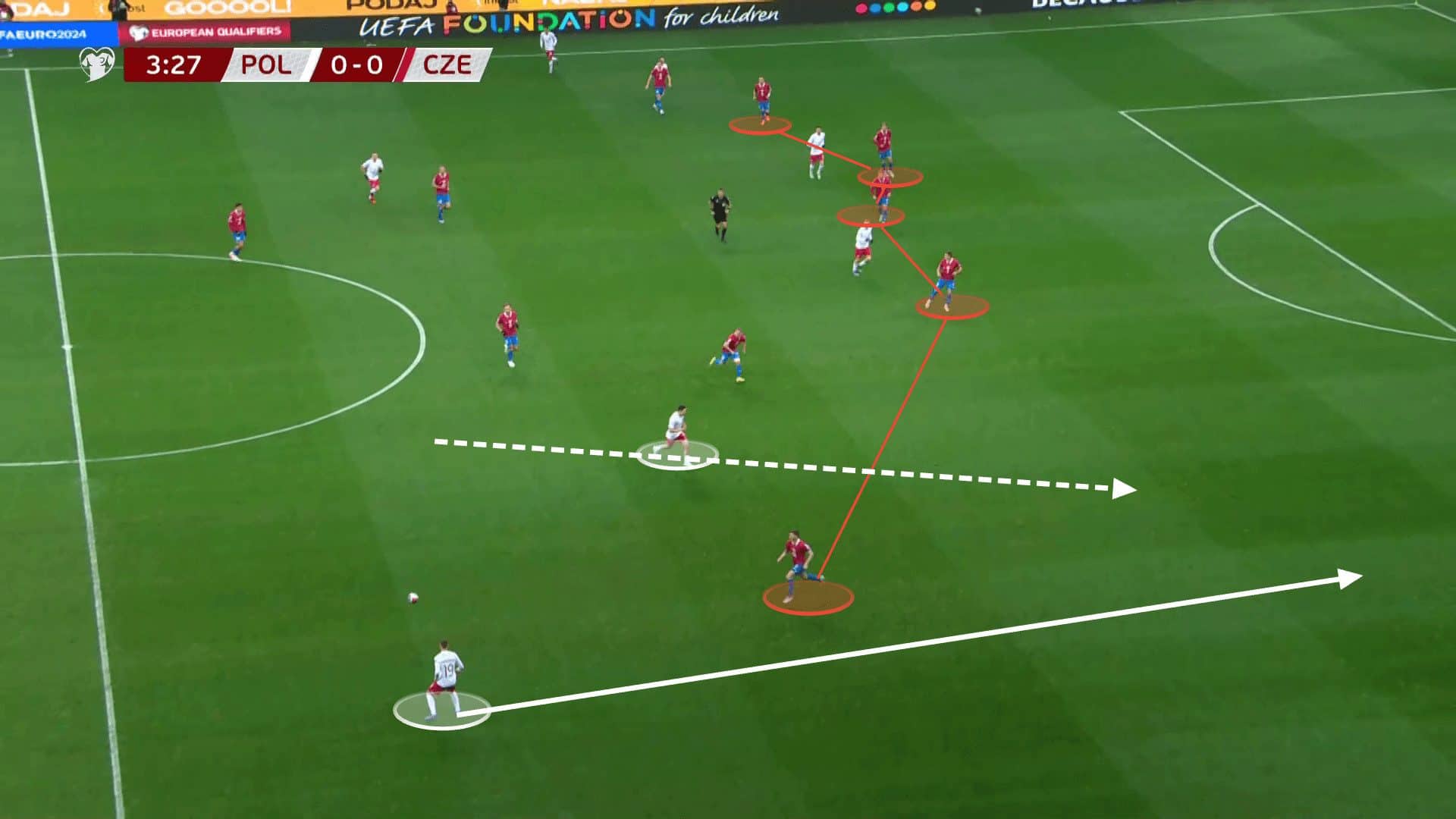
The movement of the two strikers during the underlapping runs will be critical to the success.
The image below shows another run made from the right central midfielder into the wide right channel, moving while in his marker’s blind side.
In order to maximise the amount of space the midfielder has to receive the ball, the near-sided striker makes a decoy movement towards the ball to drag the wide central defender away from the wide channel.
Świderski’s movements will unlock the space needed in the wide channels so the recipient has time to pick out the right cross.
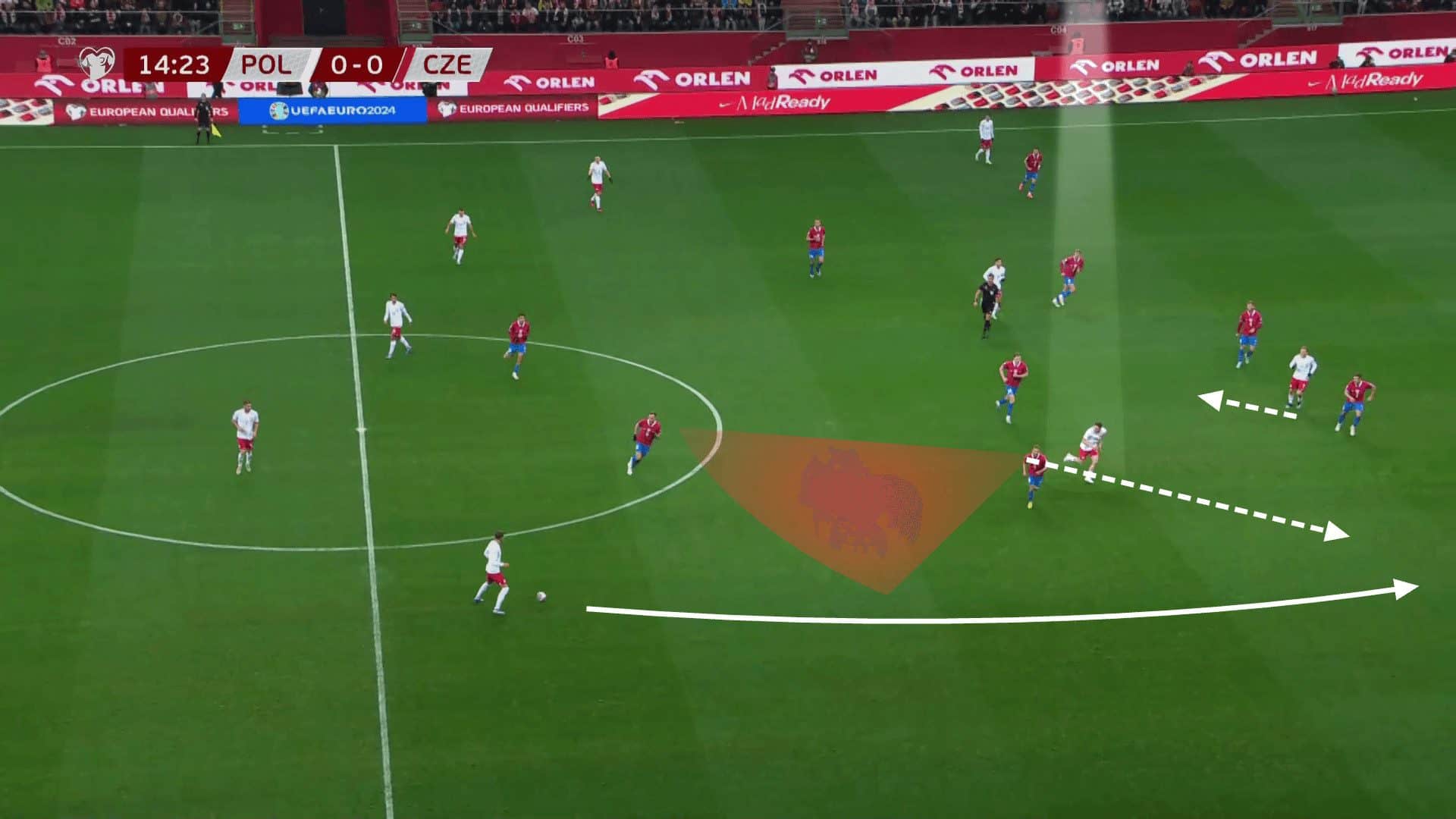
One issue that Poland have is the overly direct nature of their play.
As we have just stated, the central midfielders will be constantly making attacking runs beyond the last line.
In some instances, the striker will already be making their run into that space, meaning both players attack the same space, and the wing-back will have no support on his side.
He will be forced to play the forward pass to avoid losing possession, even if the opposition is tracking the runs, which will result in Poland having many unsuccessful long balls.
Many of Poland’s attacks will involve a risky pass into the final third, which is tough to execute.
At the same time, the result will be that they lose possession and will not have the midfield presence to help defend the counterattacks because of those same runs.
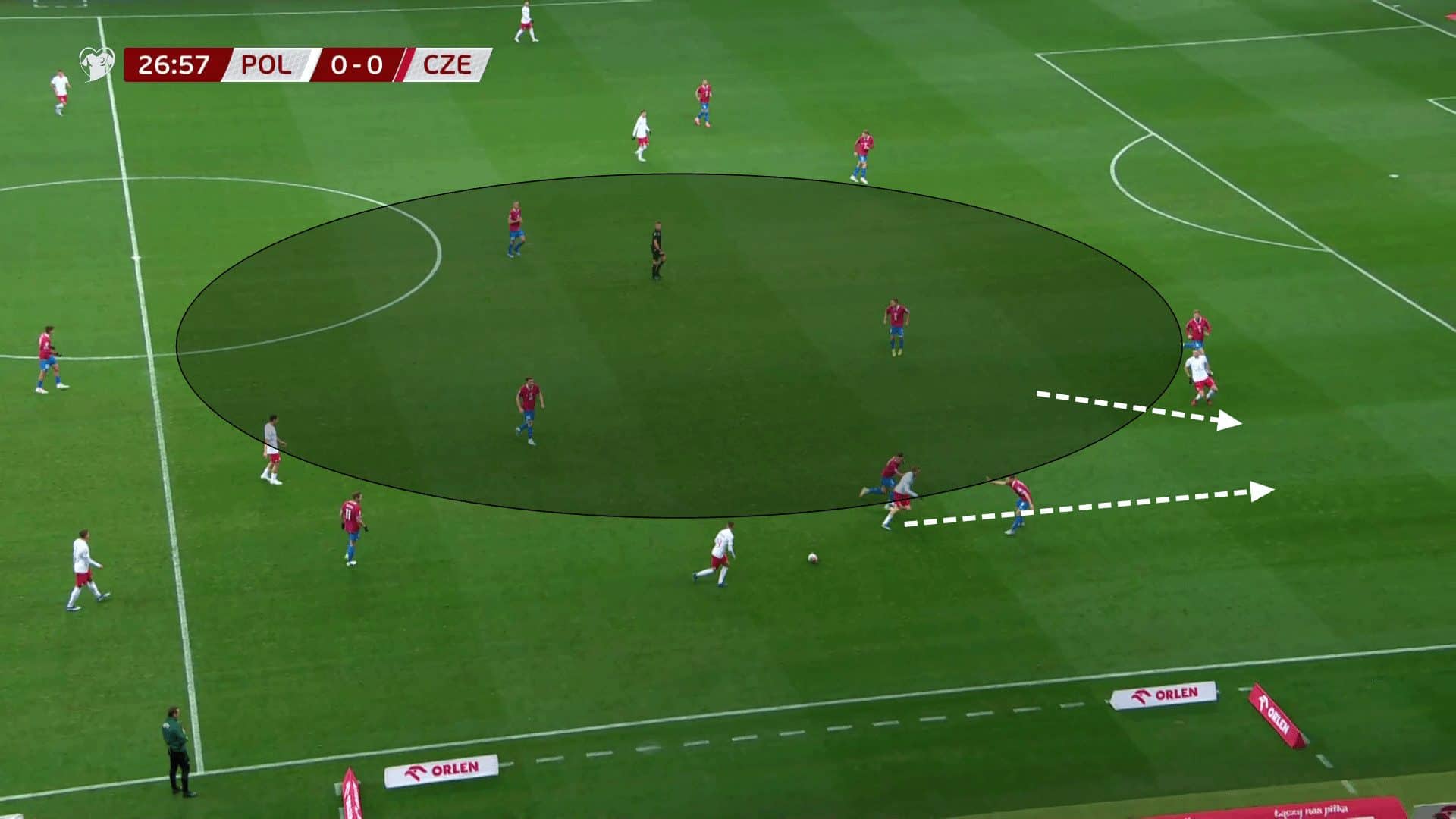
Frankowski’s decision-making and technical quality will be essential to Poland’s success down the right flank.
Primarily acting as an outlet, he will be responsible for making the runs in behind most frequently.
However, he will have many occasions with the ball at his feet where his decision-making will be decisive.
Due to the limited ball responsibility he usually has, he doesn’t have the experience in making decisions under pressure in his own half.
As a result, when the pass for an underlapping run is on, he is sometimes too focused on his individual battle with the full-back when he is usually more isolated and isn’t aware of the supporting runs being made around him.
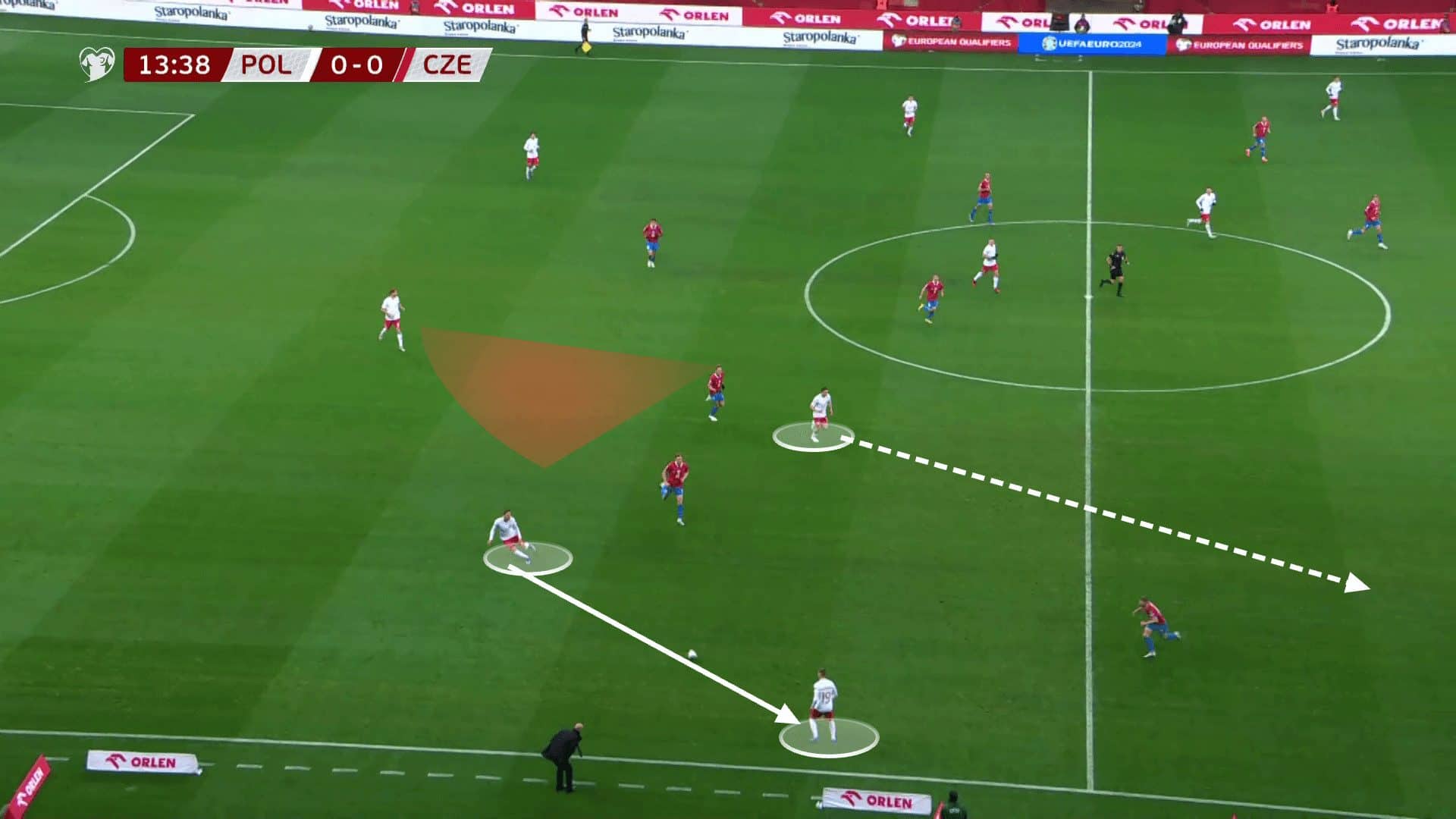
When the outside centre-backs carry the ball up the pitch, we will see the wing-backs attacking the space behind the opposition block, forcing them to retreat towards their own goal.
In those moments, Lewandowski will often try to drop deeper to receive the ball between the lines and link play.
As mentioned earlier, he will be crucial to Poland’s attempts to play through central spaces, and we will commonly see him turning with the ball before switching it out wide to the opposite wing-back.
Jakub Kiwior’s brave and strong passing qualities will mean that we will often see this dynamic coming from the left side of the pitch before Lewandowski switched the play to Frankowski.
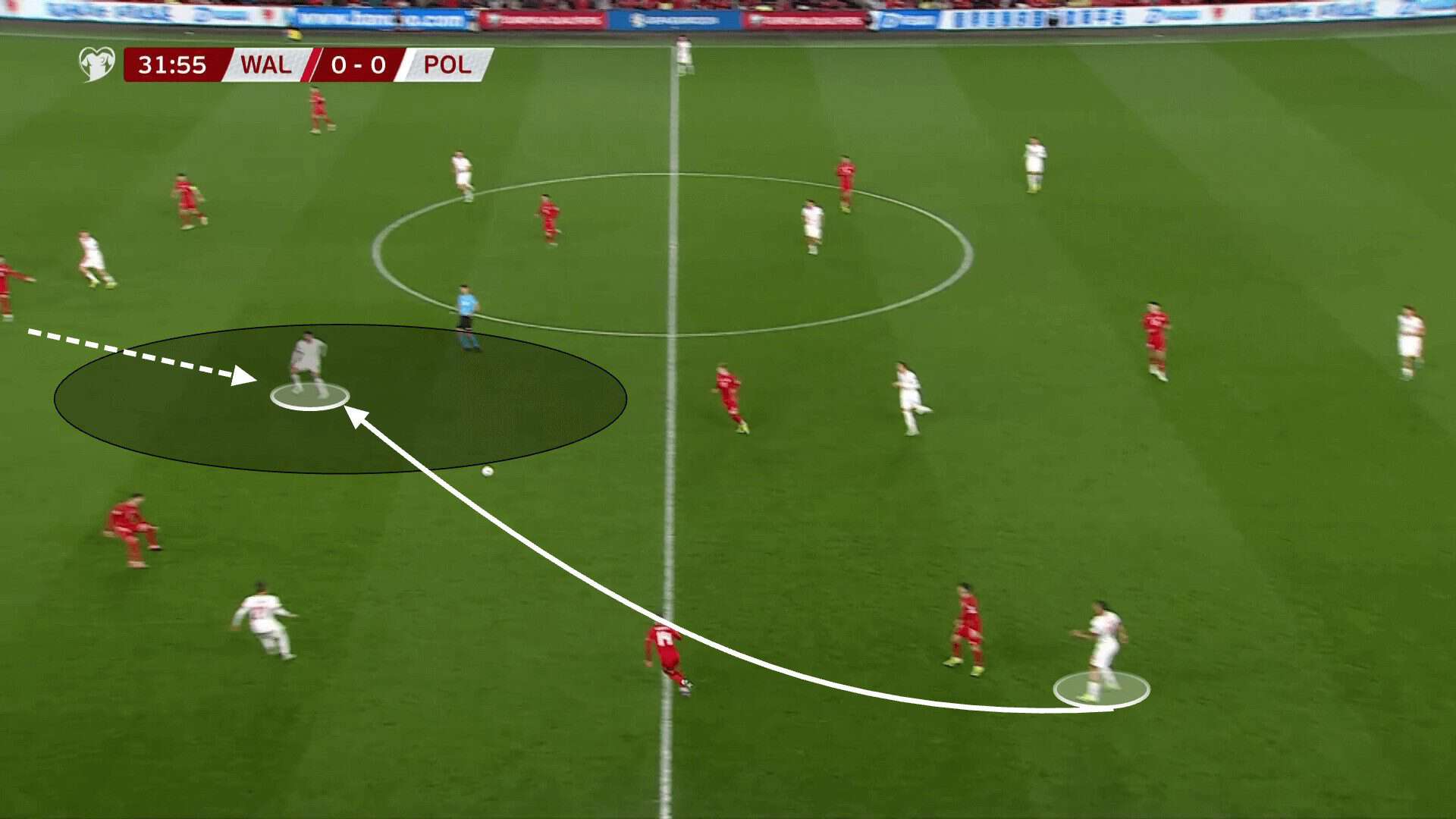
During phases of settled attacking possession outside the opposition penalty area, Piotr Zieliński will be critical to dictating the tempo at which Poland play and when to play the final pass for an attacker.
His ability to change direction at any angle and high speed mean that he can offer a threat from all areas of the pitch.
He will roam freely across the width of the pitch to support attacks inside the opposition’s third.
As we see in the example below, he is able to manipulate the opposition to step up towards the ball before quickly playing a one-two to exploit the space the opposition have just given up.
His technical quality allows him to consistently play these quick passing combinations and receive the ball in tight spaces without losing the ball.
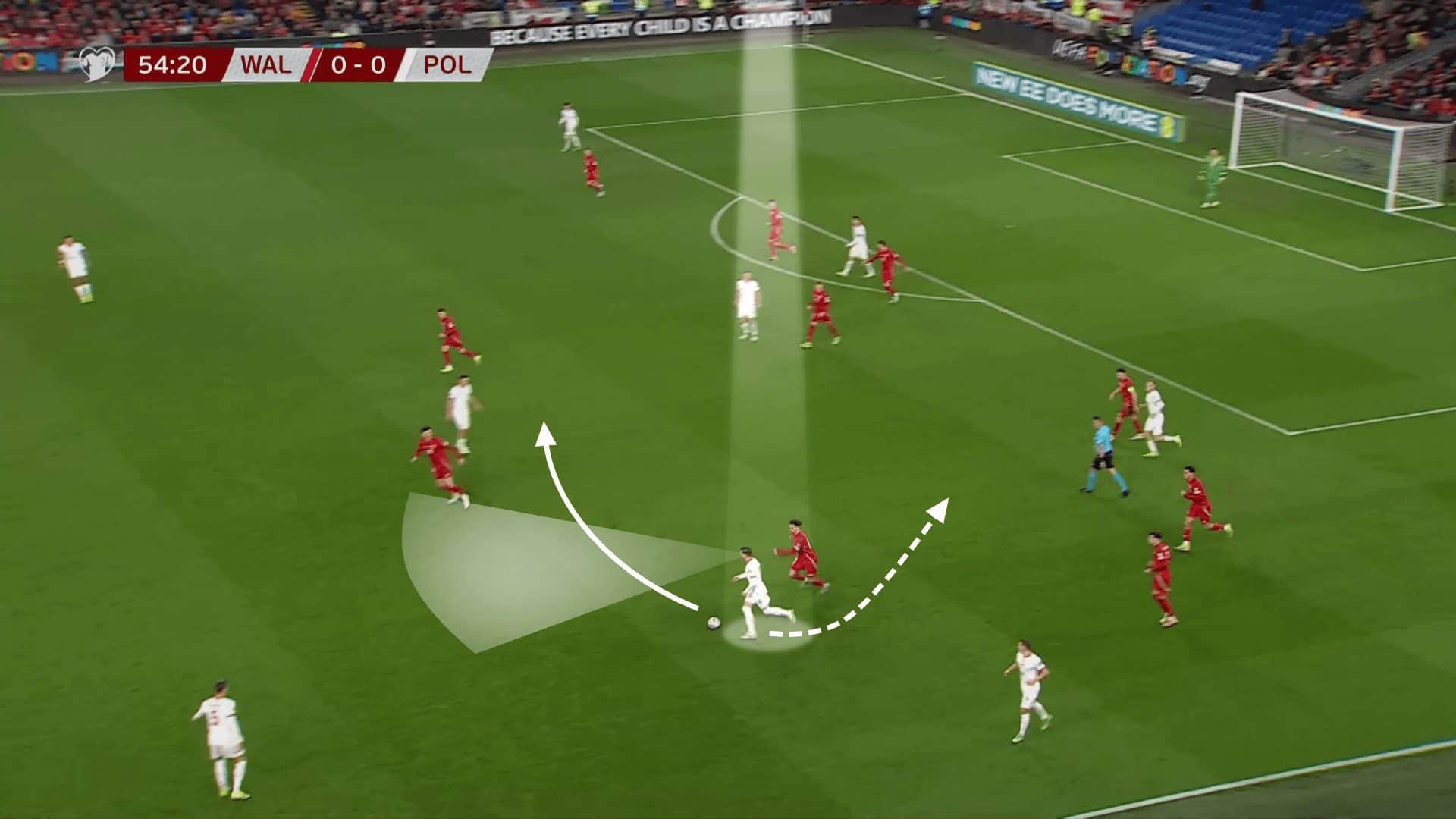
We will commonly see Poland attempting to cross the ball into the box when facing an opposition defensive unit camped in the penalty box.
With the aerial quality of the strike partnership, as well as Piotrowski, who will crash the box from deep, there are three players who are capable and have shown the quality to consistently score headed chances.
The wing-backs will also be arriving at the back post, while Zieliński will collect loose balls around the edge of the box and pose a threat from the edge of the box.
There is a lack of quality delivery into the box, which will cause Poland issues with executing their attacks, but if the delivery is right, Poland will have the numbers to cause chaos in the box and get shots off.

Overall, we will see Poland patient across their build-up if they are allowed time on the ball but will speed up as they get closer to goal and look for one killer pass that can transform a build-up situation into a shooting opportunity within a matter of seconds.
The quality of passing isn’t at the highest standard, meaning that the attacking players won’t receive the ball in favourable areas often.
Poland’s chances at success will depend on what happens in the few chances that the Polish attackers do get.
Defensive Phase
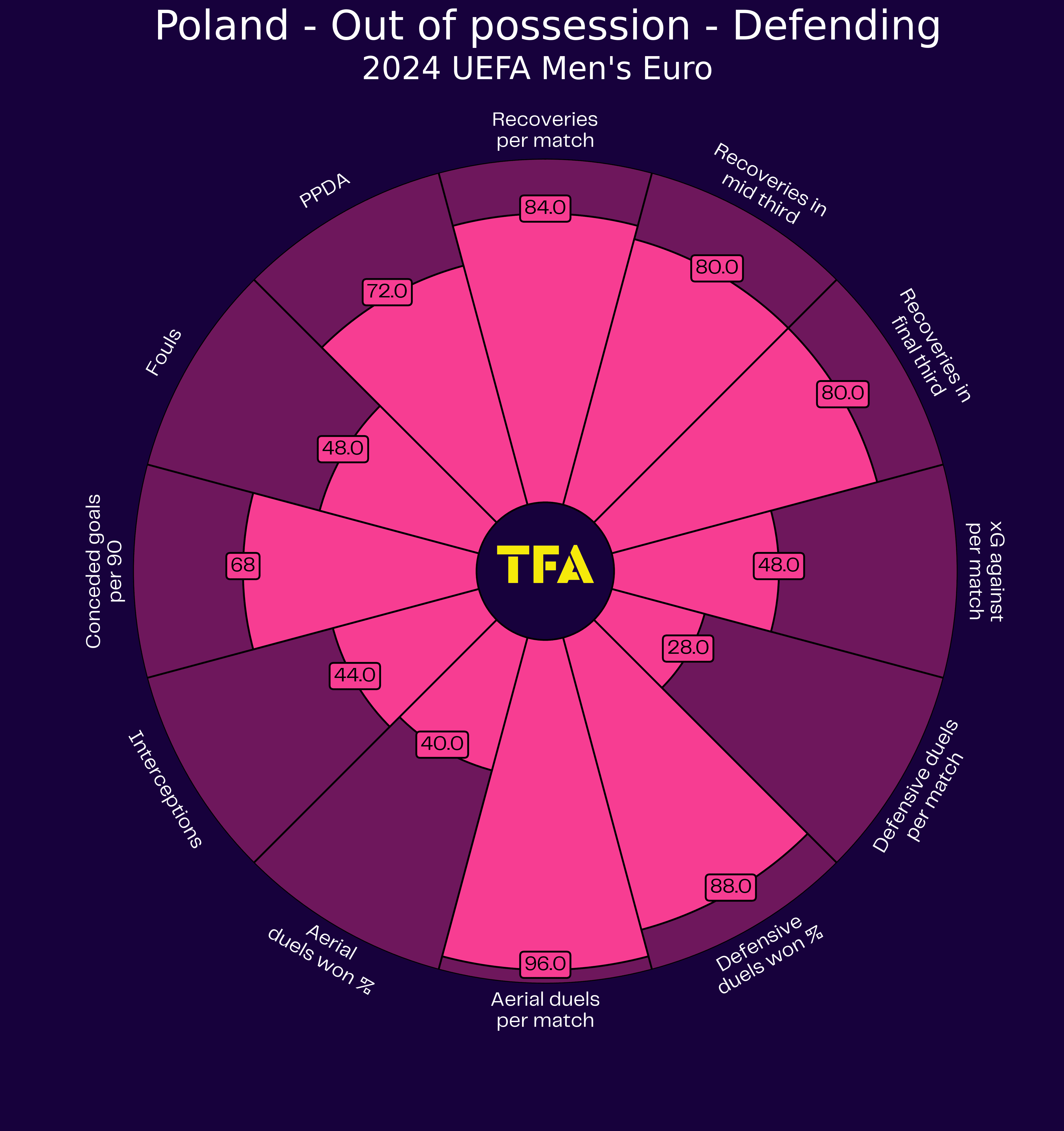
The out-of-possession graphic shows Poland’s defensive strengths.
They force opponents to attempt longer balls, creating many aerial duels per match, while the number of ground duels is lower.
With Poland’s mid-block, they prevent opponents from getting space in central areas and force long balls either into the striker or behind the opposition line.
This allows them to make many recoveries per game, as the shape is strong, so when a player attempts the forward pass, Poland can instantly cover it, even if they do lose more aerial duels than would be expected of a physical side.
When out of possession, they will stick to their 5-3-2 system.
The wingbacks engage with the opposition wingers, while the outside central midfielder comes over to prevent a numerical superiority.
Having three central defenders means there is always cover for the wing-back if he is dribbled past, and there is still enough defensive cover in the box for when a cross is played.

Inside the mid-block, the strikers prevent any central progression to the midfield while the outside central midfielder engages pressure with the opposition full-backs or outside centre-backs.
The angle of pressure is designed to funnel the opponents to play a forward pass under pressure into the front line, where defenders are ready to step up and anticipate the pass.
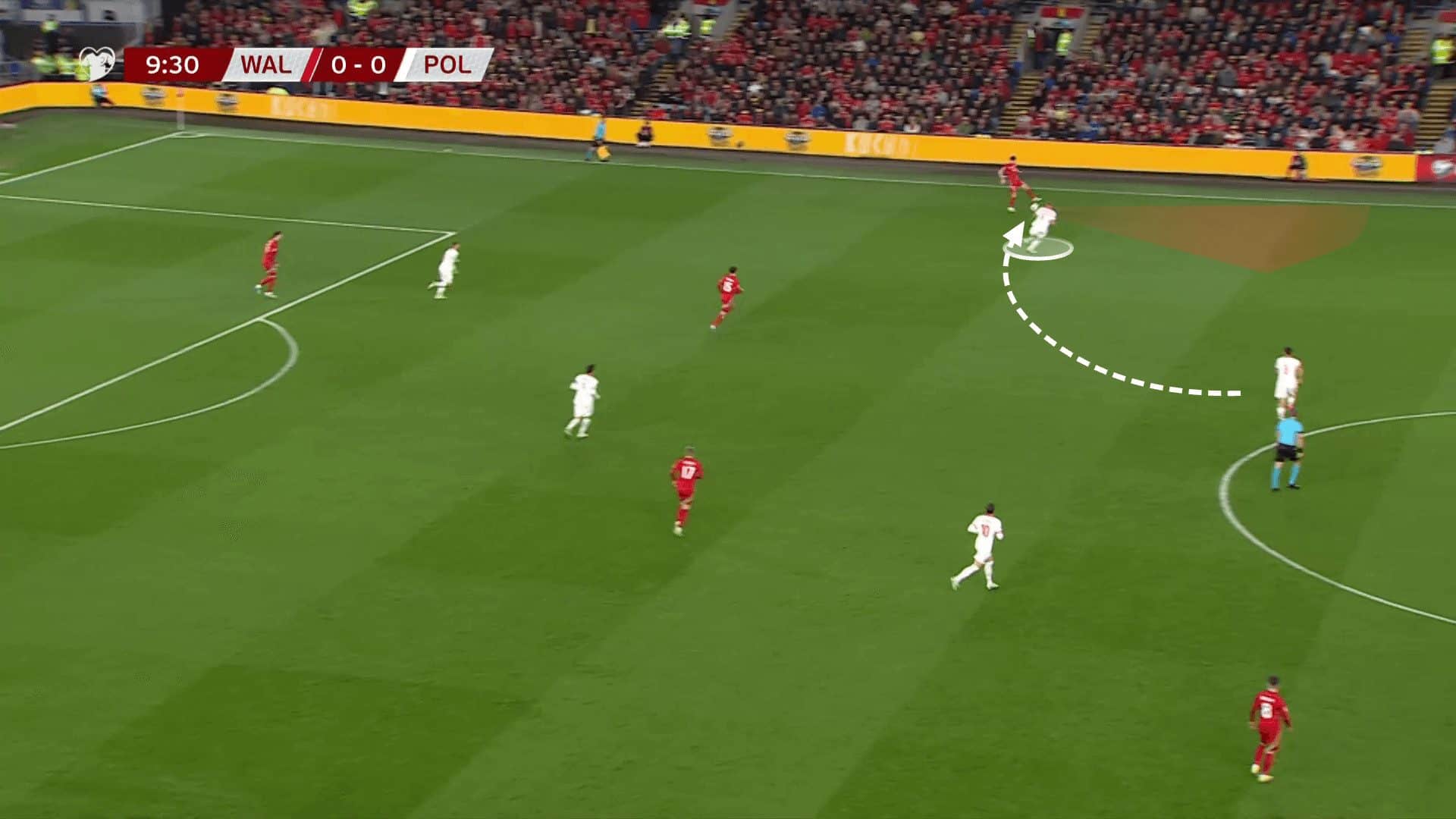
The issue that arises from having the central midfielder step up to press the wide player in the build-up is that the midfield unit can be stretched.
Poland attempt to keep the three midfielders compact, but as the far-side midfielder must shuffle over to the other half of the pitch, Poland leave the centre of the pitch unguarded.
In central areas, it is the job of the strikers to cover passes played through the centre, but after the ball is played out wide, the angle of the pass to the holding midfielder becomes open due to the midfielder moving while out of sight of the centre forwards.
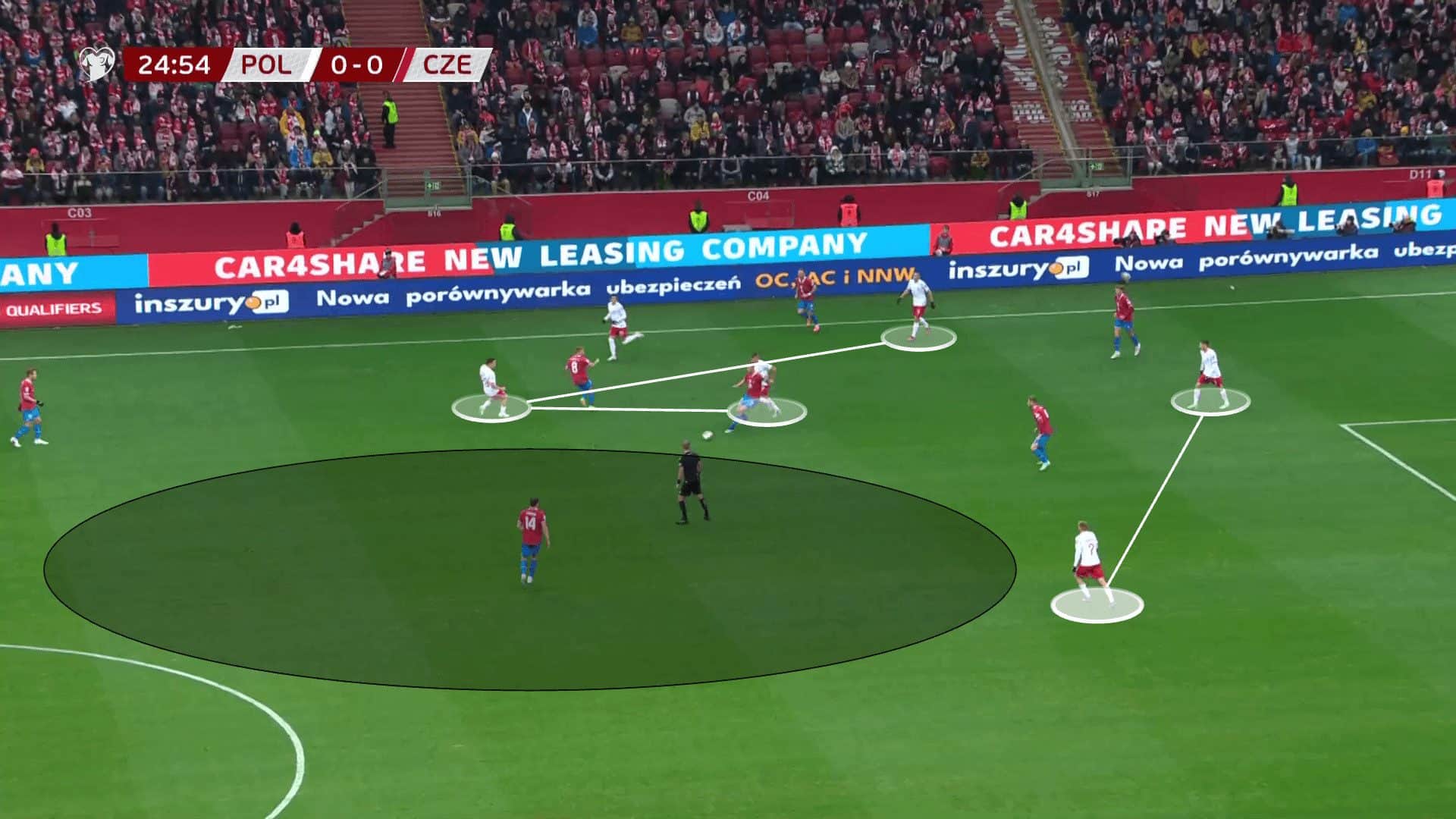
The central defenders will be vital to the success of Poland’s pressure during their mid-block.
They must be brave in stepping up from their position to follow the attackers who drop into the spaces the Polish midfield vacates when pressing the first line.
If they can be brave and successful in judging the appropriate moment to intercept the ball, Poland will be able to generate multiple counterattacking opportunities.
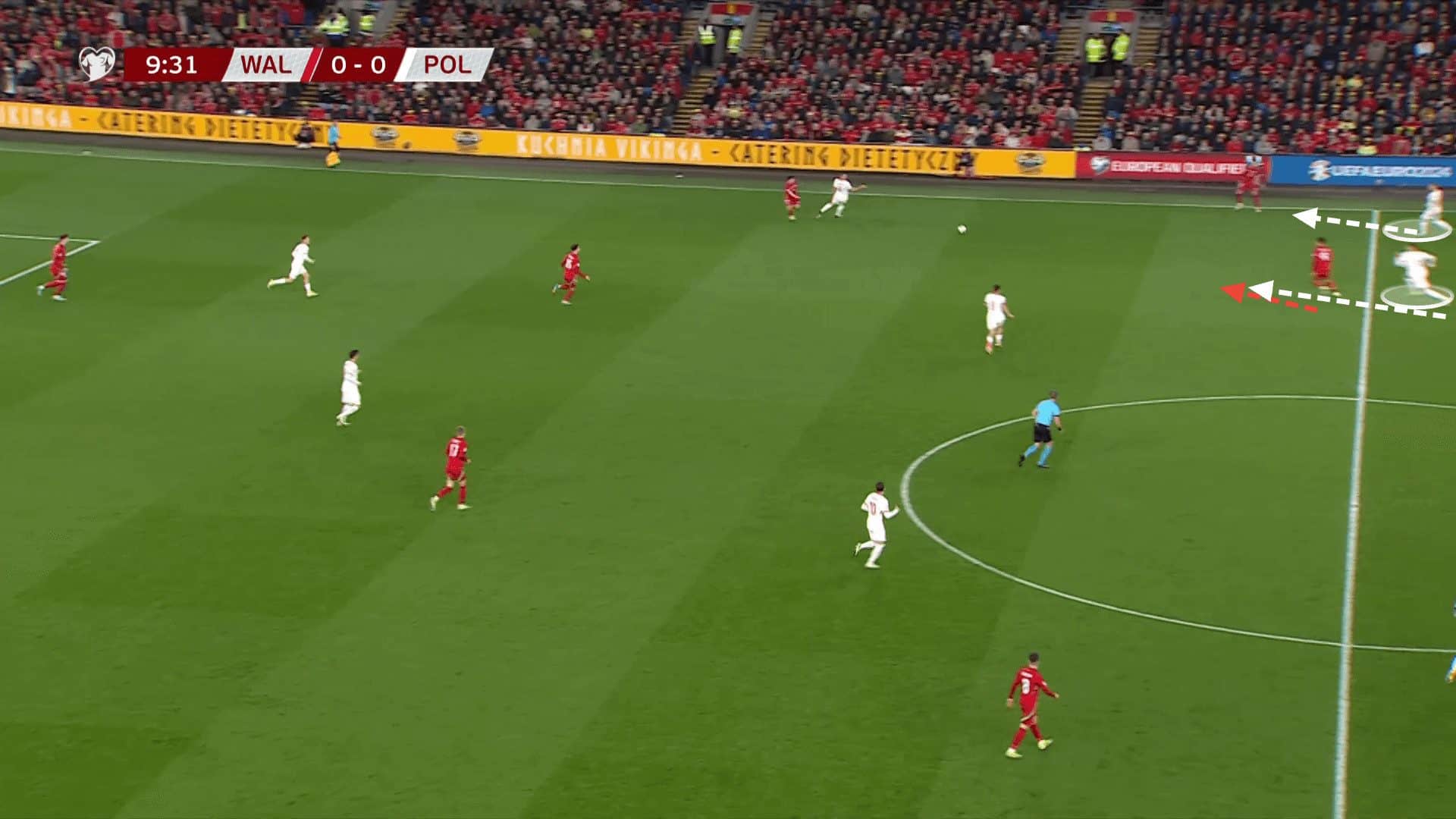
However, if the timing is off, Poland could concede within seconds.
A mistake in stepping up from defence will create gaps in the defensive line that the opposition can penetrate instantly.
The good thing about the back five is that even when a mistake is made, there will be other defenders able to cover the space left, but not the extra attacker left open after he evades the pressure from the centre-back.
Poland’s central defender has been rotated fairly regularly, with no one being able to claim the spot as their own.
If this role isn’t performed to a high standard, Poland will struggle from the off.
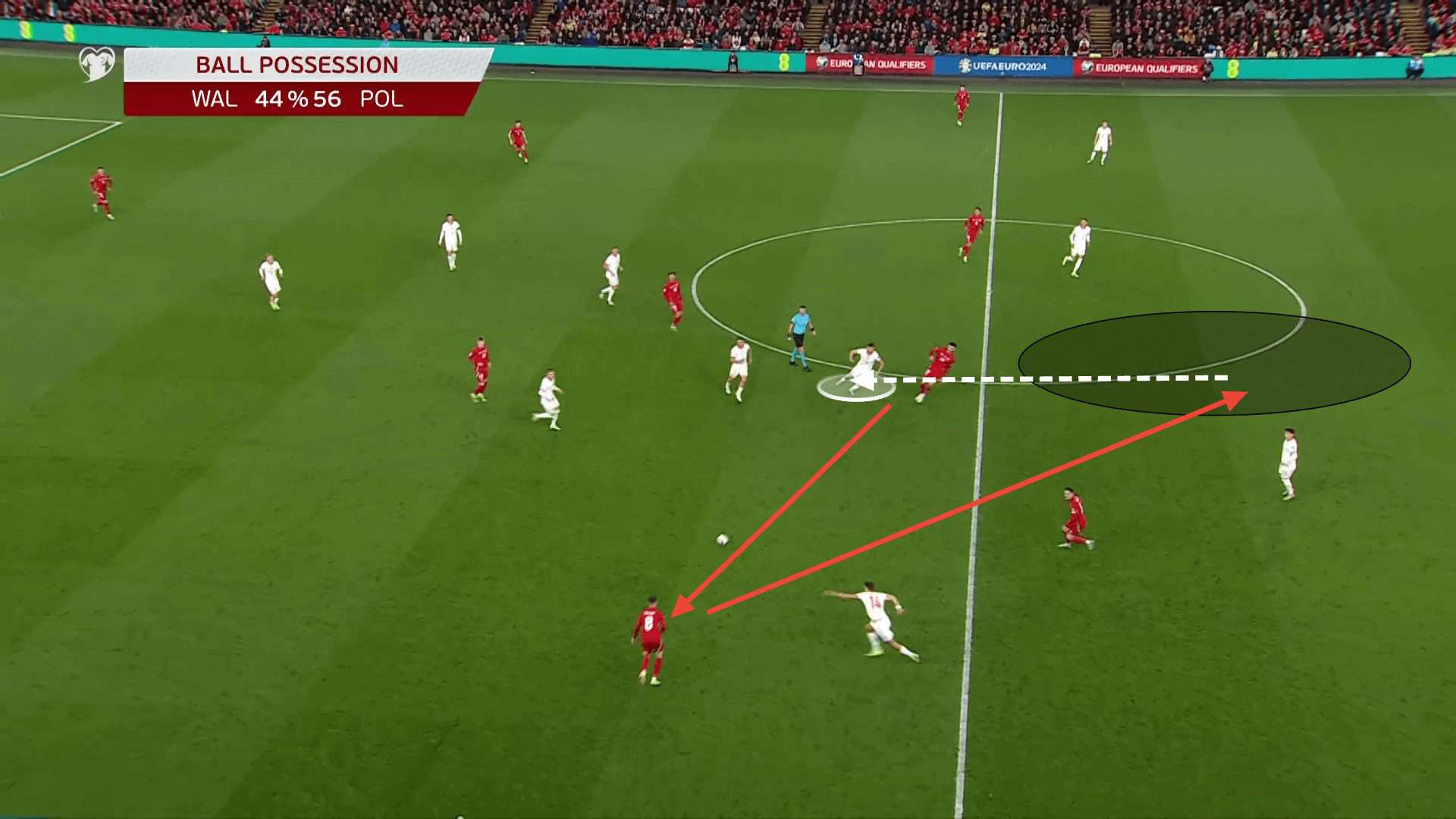
One other problem Poland could face is when dealing with balls played in behind their back line.
The central defenders at Poland’s disposal aren’t the most mobile bunch.
Furthermore, using natural wingers at wing-back will cause individual mistakes such as the one in the picture below, where Frankowski’s body position is square, meaning he cannot cover the space behind him that the attacker is moving into.
Without the natural defensive instincts, we could see some individual mistakes occur.
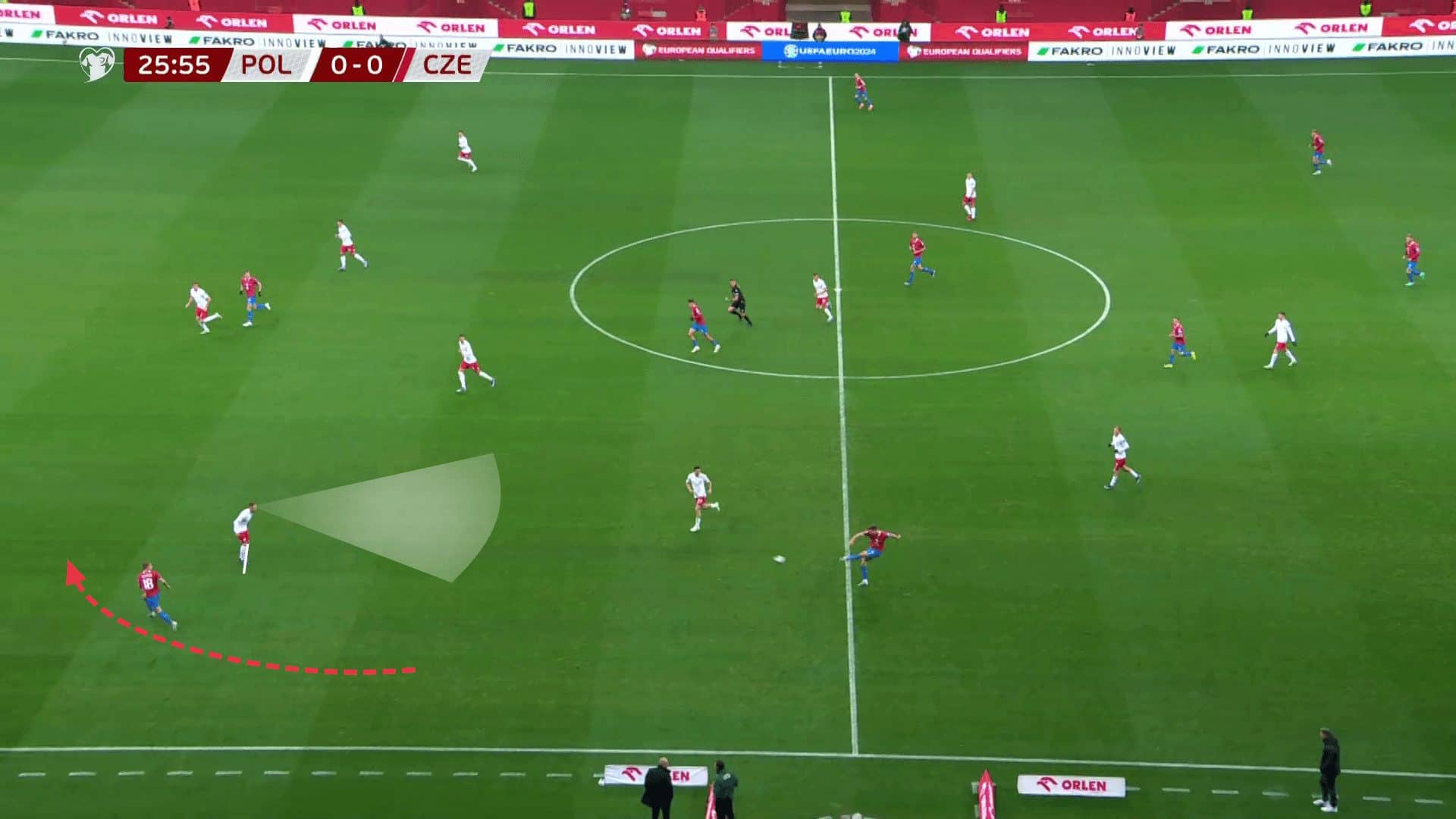
Poland will likely drop the defensive line when facing the attacking quality of France, the Netherlands, and Austria, so we may see them less likely to press and more focused on limiting the space between the defensive lines.
Transitions
Much of Poland’s attacking threat will likely occur during transitional opportunities as a result of the strength of the opposition and Poland’s likely attempts to defend deeper and give up possession to avoid giving up any space in between the middle of the pitch.
Whilst defending deep, Świderski will drop a little to connect with the midfield three to help compete for second balls.
Having the four players in the middle of the pitch whilst defending deep will allow them to help evade counterpressing efforts.
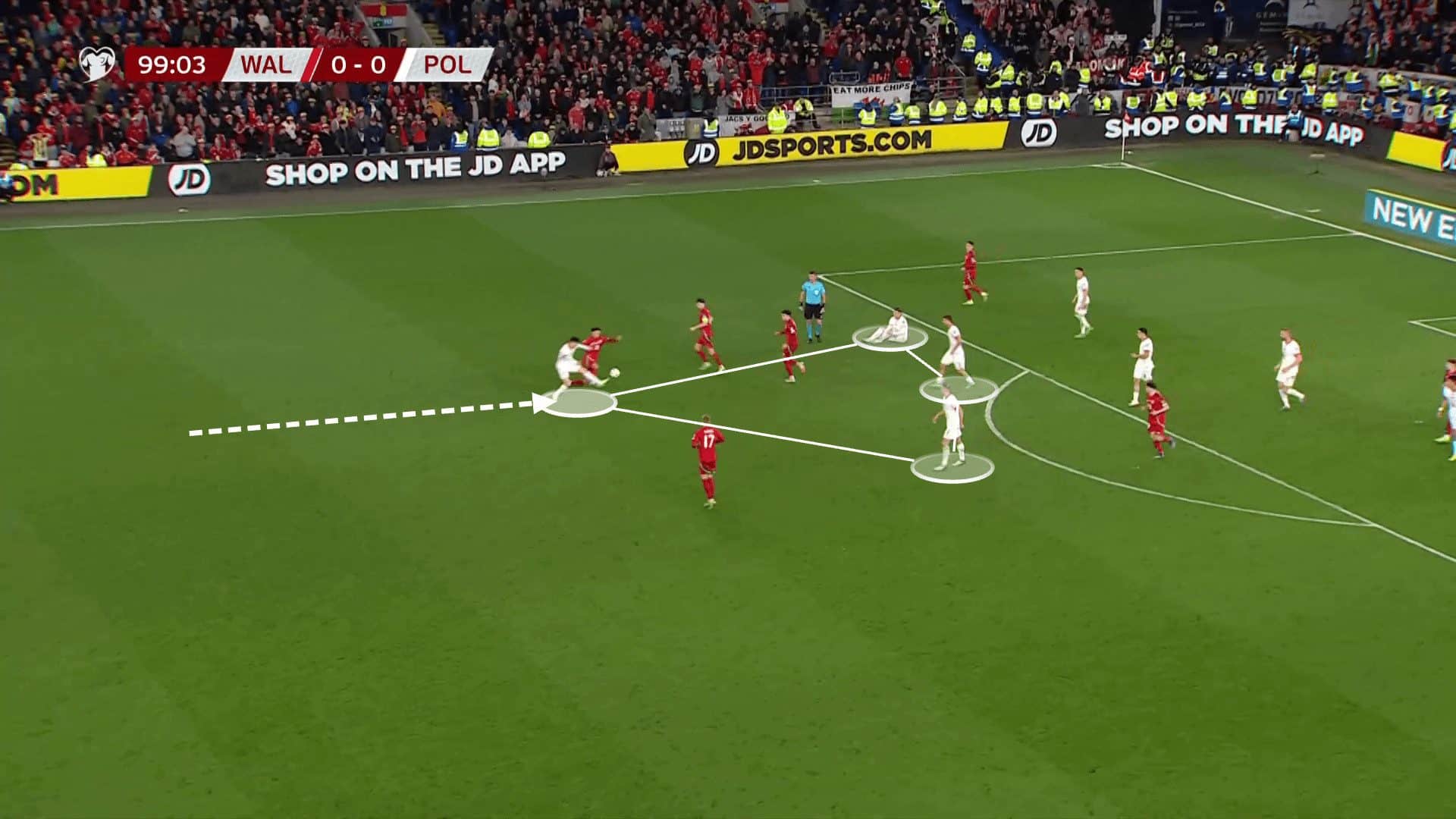
The aim will be to give the ball to Lewandowski up front, who will hold it up.
The wing-backs will attempt to move up the pitch while the ball is held up and act as outlets in both wide areas.
During this time, the midfield unit will move up to support Lewandowski as a passing option when under pressure.
One issue of using wing-backs as the outlet is the length of time it will take for the wing-back to leave their own box before making the run beyond the opposition line.
In that time, it will be possible for opponents to attempt to dispossess Lewandowski, and he will face a significant challenge fending off numerous opponents.
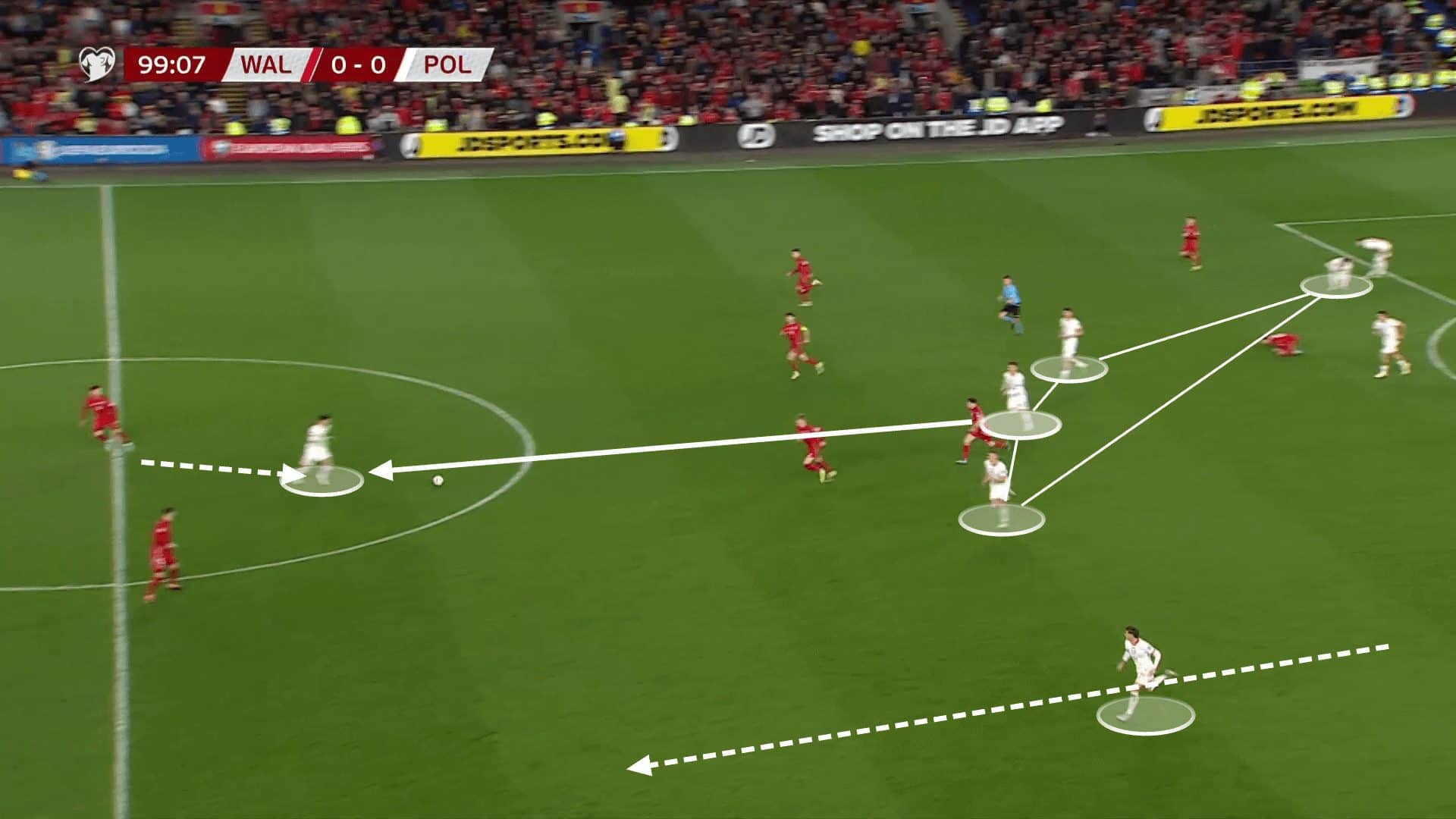
Poland may also face some issues dealing with opposition counterattacks.
The problem is the lack of technical security amongst the spine of the squad.
Being unable to deal with the ball in tighter spaces, there will be many turnovers when Poland attempt to play more intricate passing moves, which will mean they will have to defend against many counters.
As we can see in the example below, Świderski receives the ball in between the lines but is unable to turn quick enough to release the wing-back, making a run, which causes Poland to lose the ball.
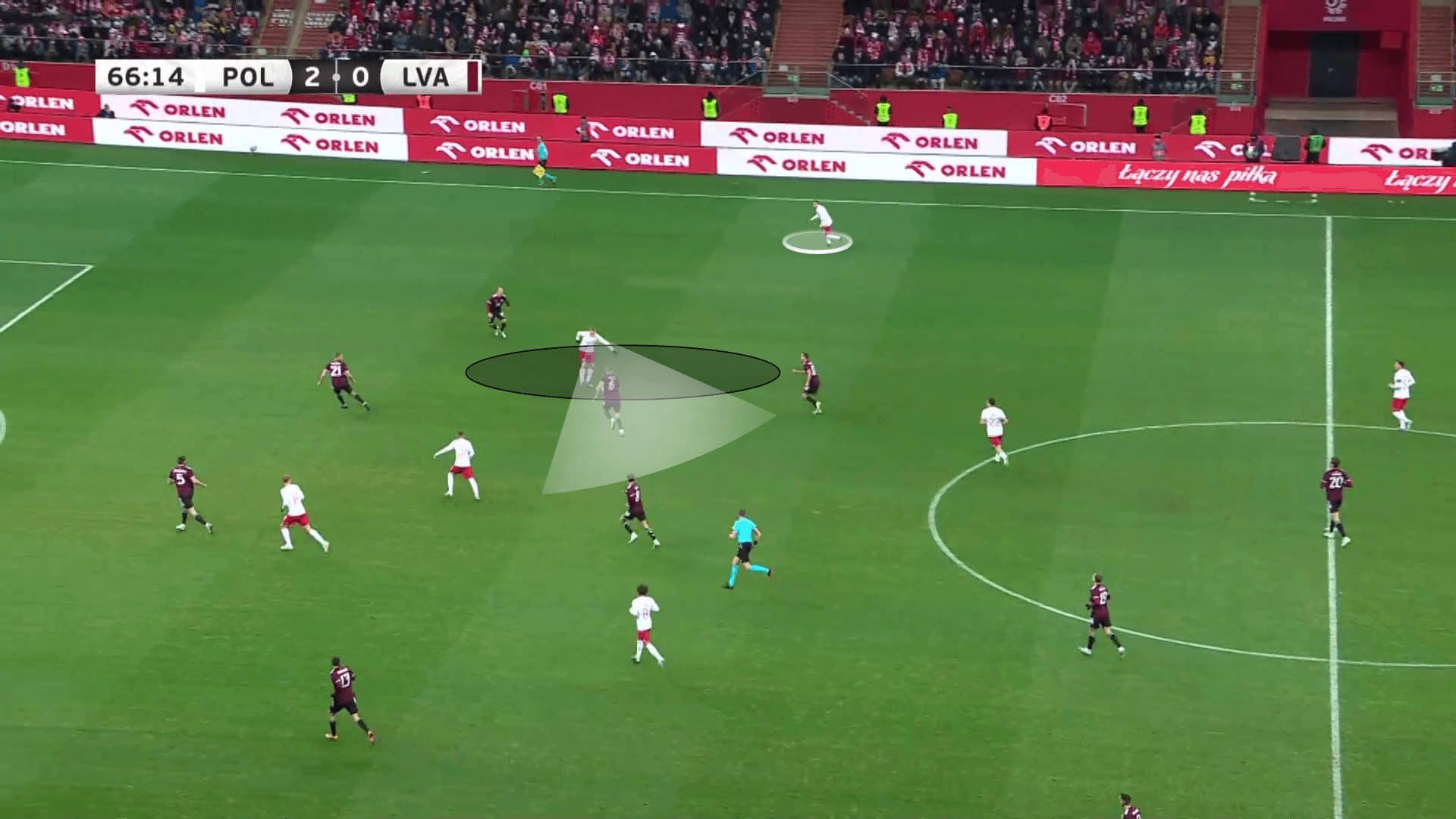
Losing the ball when players are making their attacking runs will cause Poland to deal with counterattacks outnumbered, where only the central defenders and holding midfielder is back to deal with them.
As a result, we may see Poland concede chances due to their lack of ability to keep possession, whether that is in their own third or the opposition’s third.
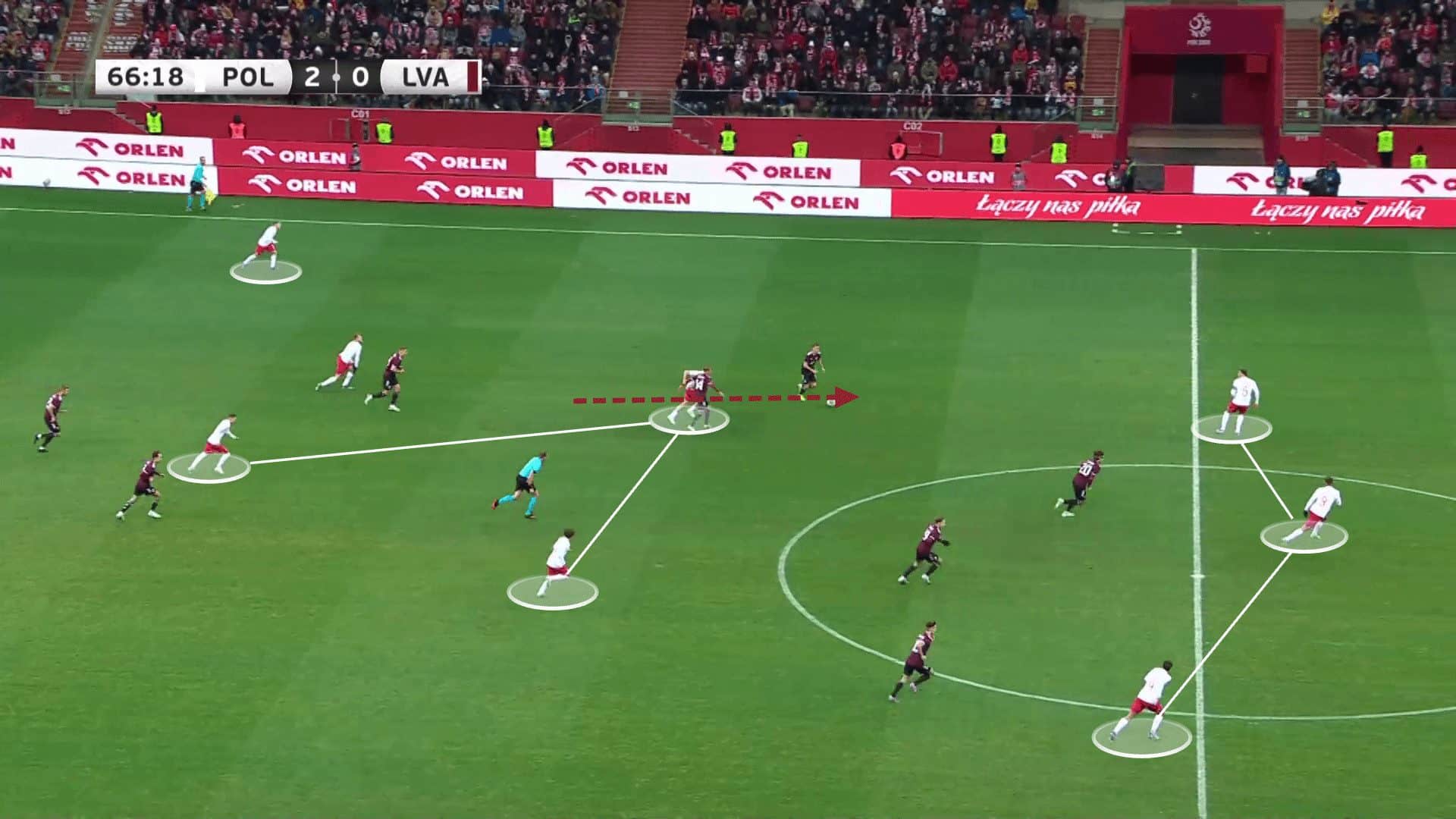
Forwards
The attacking position next to Lewandowski is not guaranteed.
Both Milik and Piatek have had strong patches of form, which could see them take the spot in the starting line-up.
Each player has different qualities that can bring Poland success, but the likelihood of having the right-side forward making out to in runs will likely favour a left-footed player to get the spot.
Midfielders
Poland’s midfield options are fairly limited.
The players in the squad are all players who are capable of affecting the match, but the likes of Moder have had limited game time after returning from injury.
Sebastian Szymanski’s minutes will be limited by Zieliński, who is a mainstay in the side.
Damian Szymanski and Romanczuk could compete for the holding midfield roles, although Slisz has been preferred in recent weeks.
Defenders
Matty Cash will be looking to gain the right wing-back spot, but his appearances for Poland have not been up to the standard, and Frankowski has been more consistent in his performances.
The central defensive options between Bochniewicz, Salamon and Walukiewicz are all ones which have been underwhelming for their clubs but could all gain the spot as a central defender with the spot being up for grabs and Kiwior and Bednarek looking set in their positions as the outside centre-backs.
Puchacz, at left wing-back, can inject pace into the side but has also been playing at a much lower standard than that of Zalewski.
Key Player
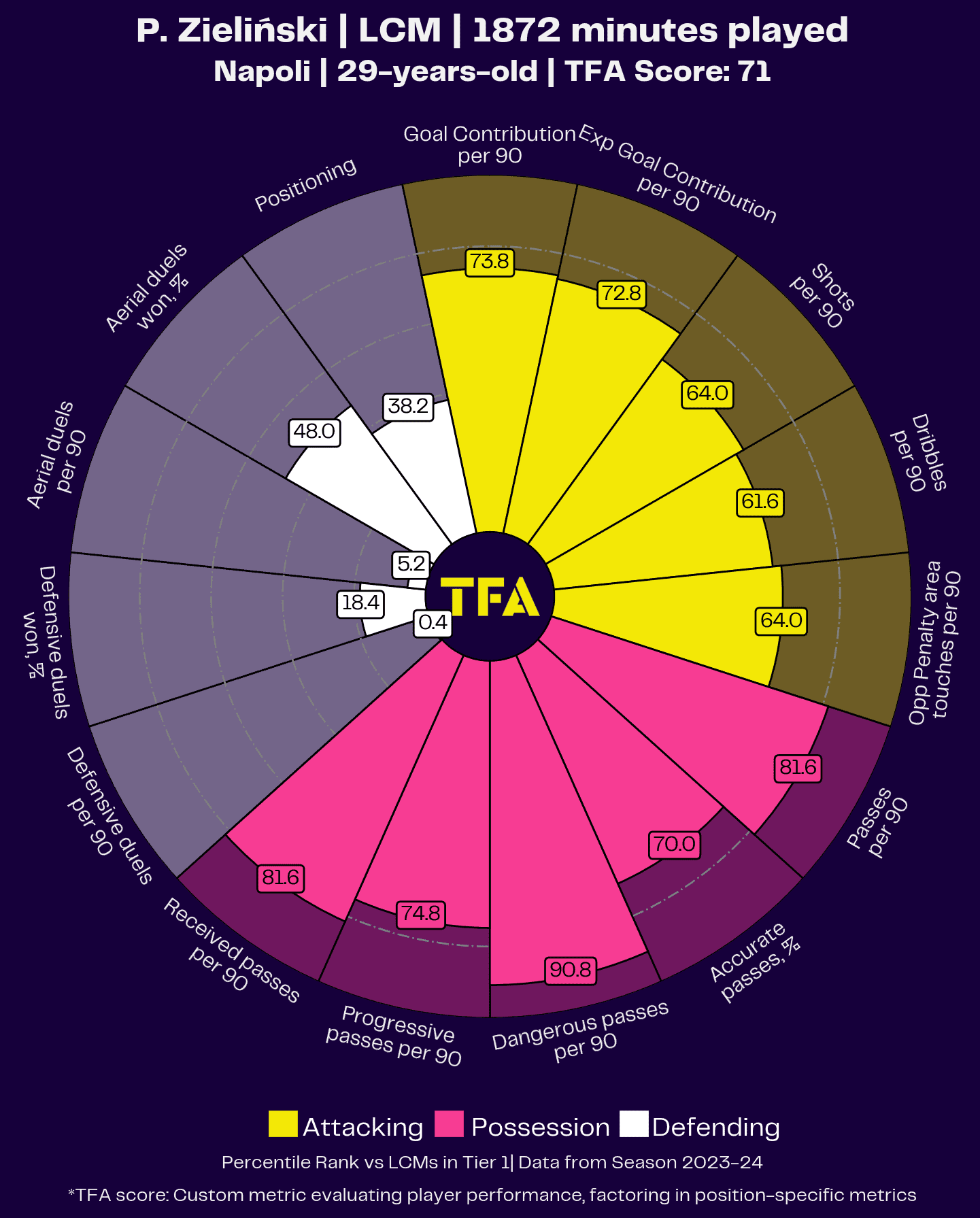
Zieliński will be critical to Poland’s hopes of any success in the tournament.
From deep, he will be able to dictate the tempo of the game and stop Poland from an overly direct playing style due to his ability to retain possession of the ball.
Under pressure, he will not panic but instead find an open teammate.
He will support teammates in the build-up to help take the pressure off any players who are less comfortable on the ball.
In attack, Zieliński can contribute through a variety of ways.
He has the weight of pass to release players into space while also having the ability to make the right decision and not be predictable by doing it every time.
In tight spaces, Zieliński is capable of receiving and turning under pressure, and combining with his teammates.
He is also equally comfortable on both feet.
As we stated earlier, his ability to turn at any angle means he can play to a high standard in any area of the pitch while being able to shoot from distance, posing a threat from long distance.
We can see from the statistics above Zieliński is one of the most dangerous passers in Europe.
His role for Napoli doesn’t require him to get involved in the build-up regularly, but he’s shown the ability to do so when wearing the red and white shirt of his nation.
He will be tasked with progressing the ball up the pitch, releasing the front line into the final third and attempting to score when entering the box, as well as being key in taking set pieces.
Tournament Prediction
Based on the analysis above, Poland’s setup does give them a solid base which aims to make them as tough to beat as possible.
However, due to the strength of the other teams in their group and Poland’s limited pace and power during transitions, we are unlikely to see Poland make it into the knockout stages.
Their match against an injury-riddled Austria will be crucial to their hopes of making it out of the group as one of the best third-placed teams.
Still, in order for that to be possible, they will also have to avoid conceding many goals against the likes of France and the Netherlands.
There is a chance of seeing them in the knockouts, but their limits in transitions prevent them from having enough threat and goals as a team who will likely give up possession to their opponents.

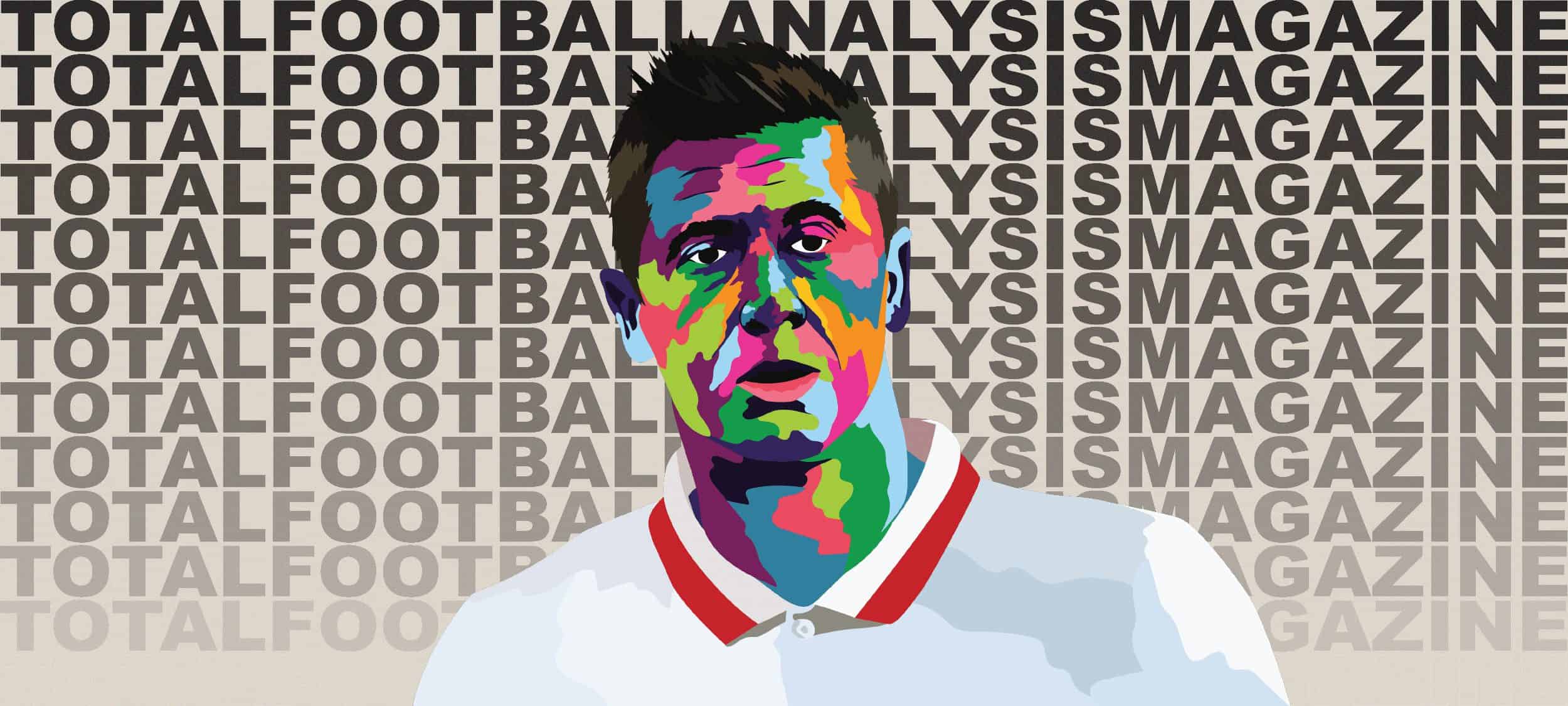




Comments